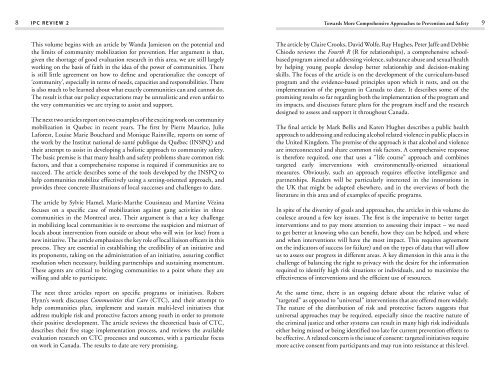Revue de L' R e v I e W - Faculty of Social Sciences - Université d ...
Revue de L' R e v I e W - Faculty of Social Sciences - Université d ...
Revue de L' R e v I e W - Faculty of Social Sciences - Université d ...
Create successful ePaper yourself
Turn your PDF publications into a flip-book with our unique Google optimized e-Paper software.
I P C R e v i e w 2<br />
Towards More Comprehensive Approaches to Prevention and Safety<br />
<br />
This volume begins with an article by Wanda Jamieson on the potential and<br />
the limits <strong>of</strong> community mobilization for prevention. Her argument is that,<br />
given the shortage <strong>of</strong> good evaluation research in this area, we are still largely<br />
working on the basis <strong>of</strong> faith in the i<strong>de</strong>a <strong>of</strong> the power <strong>of</strong> communities. There<br />
is still little agreement on how to <strong>de</strong>fine and operationalize the concept <strong>of</strong><br />
‘community’, especially in terms <strong>of</strong> needs, capacities and responsibilities. There<br />
is also much to be learned about what exactly communities can and cannot do.<br />
The result is that our policy expectations may be unrealistic and even unfair to<br />
the very communities we are trying to assist and support.<br />
The next two articles report on two examples <strong>of</strong> the exciting work on community<br />
mobilization in Quebec in recent years. The first by Pierre Maurice, Julie<br />
Laforest, Louise Marie Bouchard and Monique Rainville, reports on some <strong>of</strong><br />
the work by the Institut national <strong>de</strong> santé publique du Québec (INSPQ) and<br />
their attempt to assist in <strong>de</strong>veloping a holistic approach to community safety.<br />
The basic premise is that many health and safety problems share common risk<br />
factors, and that a comprehensive response is required if communities are to<br />
succeed. The article <strong>de</strong>scribes some <strong>of</strong> the tools <strong>de</strong>veloped by the INSPQ to<br />
help communities mobilize effectively using a setting-oriented approach, and<br />
provi<strong>de</strong>s three concrete illustrations <strong>of</strong> local successes and challenges to date.<br />
The article by Sylvie Hamel, Marie-Marthe Cousineau and Martine Vézina<br />
focuses on a specific case <strong>of</strong> mobilization against gang activities in three<br />
communities in the Montreal area. Their argument is that a key challenge<br />
in mobilizing local communities is to overcome the suspicion and mistrust <strong>of</strong><br />
locals about intervention from outsi<strong>de</strong> or about who will win (or lose) from a<br />
new initiative. The article emphasizes the key role <strong>of</strong> local liaison <strong>of</strong>ficers in this<br />
process. They are essential in establishing the credibility <strong>of</strong> an initiative and<br />
its proponents, taking on the administration <strong>of</strong> an initiative, assuring conflict<br />
resolution when necessary, building partnerships and sustaining momentum.<br />
These agents are critical to bringing communities to a point where they are<br />
willing and able to participate.<br />
The next three articles report on specific programs or initiatives. Robert<br />
Flynn’s work discusses Communities that Care (CTC), and their attempt to<br />
help communities plan, implement and sustain multi-level initiatives that<br />
address multiple risk and protective factors among youth in or<strong>de</strong>r to promote<br />
their positive <strong>de</strong>velopment. The article reviews the theoretical basis <strong>of</strong> CTC,<br />
<strong>de</strong>scribes their five stage implementation process, and reviews the available<br />
evaluation research on CTC processes and outcomes, with a particular focus<br />
on work in Canada. The results to date are very promising.<br />
The article by Claire Crooks, David Wolfe, Ray Hughes, Peter Jaffe and Debbie<br />
Chiodo reviews the Fourth R (R for relationships), a comprehensive schoolbased<br />
program aimed at addressing violence, substance abuse and sexual health<br />
by helping young people <strong>de</strong>velop better relationship and <strong>de</strong>cision-making<br />
skills. The focus <strong>of</strong> the article is on the <strong>de</strong>velopment <strong>of</strong> the curriculum-based<br />
program and the evi<strong>de</strong>nce-based principles upon which it rests, and on the<br />
implementation <strong>of</strong> the program in Canada to date. It <strong>de</strong>scribes some <strong>of</strong> the<br />
promising results so far regarding both the implementation <strong>of</strong> the program and<br />
its impacts, and discusses future plans for the program itself and the research<br />
<strong>de</strong>signed to assess and support it throughout Canada.<br />
The final article by Mark Bellis and Karen Hughes <strong>de</strong>scribes a public health<br />
approach to addressing and reducing alcohol related violence in public places in<br />
the United Kingdom. The premise <strong>of</strong> the approach is that alcohol and violence<br />
are interconnected and share common risk factors. A comprehensive response<br />
is therefore required, one that uses a “life course” approach and combines<br />
targeted early interventions with environmentally-oriented situational<br />
measures. Obviously, such an approach requires effective intelligence and<br />
partnerships. Rea<strong>de</strong>rs will be particularly interested in the innovations in<br />
the UK that might be adapted elsewhere, and in the overviews <strong>of</strong> both the<br />
literature in this area and <strong>of</strong> examples <strong>of</strong> specific programs.<br />
In spite <strong>of</strong> the diversity <strong>of</strong> goals and approaches, the articles in this volume do<br />
coalesce around a few key issues. The first is the imperative to better target<br />
interventions and to pay more attention to assessing their impact – we need<br />
to get better at knowing who can benefit, how they can be helped, and where<br />
and when interventions will have the most impact. This requires agreement<br />
on the indicators <strong>of</strong> success (or failure) and on the types <strong>of</strong> data that will allow<br />
us to assess our progress in different areas. A key dimension in this area is the<br />
challenge <strong>of</strong> balancing the right to privacy with the <strong>de</strong>sire for the information<br />
required to i<strong>de</strong>ntify high risk situations or individuals, and to maximize the<br />
effectiveness <strong>of</strong> interventions and the efficient use <strong>of</strong> resources.<br />
At the same time, there is an ongoing <strong>de</strong>bate about the relative value <strong>of</strong><br />
“targeted” as opposed to “universal” interventions that are <strong>of</strong>fered more wi<strong>de</strong>ly.<br />
The nature <strong>of</strong> the distribution <strong>of</strong> risk and protective factors suggests that<br />
universal approaches may be required, especially since the reactive nature <strong>of</strong><br />
the criminal justice and other systems can result in many high risk individuals<br />
either being missed or being i<strong>de</strong>ntified too late for current prevention efforts to<br />
be effective. A related concern is the issue <strong>of</strong> consent: targeted initiatives require<br />
more active consent from participants and may run into resistance at this level.

















